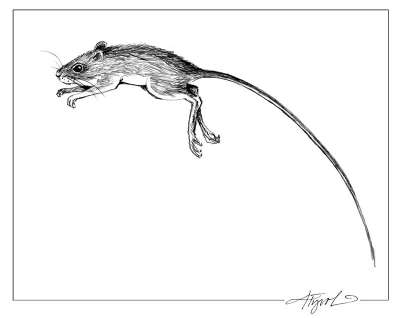
Perhaps you’ve caught a glimpse in your headlights of a mouse with a very long tail, leaping across the road at night. Or maybe your cat has deposited a specimen on your doorstep. This is the jumping mouse. My orange tabby, Marmalade, seems to specialize in catching them. The two jumping mice species in our area are unrelated to any other mice found in the New World; their closest relatives are in eastern Asia. According to Bill Kilpatrick, Professor of Biology at the University of Vermont, the ancestors of jumping mice migrated to North America when the two continents were connected millions of years ago.
The woodland jumping mouse, as its name indicates, lives in forested areas. It is hard to observe, but common in the Northeast. If you have a chance to see one up close, perhaps courtesy of a cat, you’ll notice an extremely long tail and large hind feet. The fur is bright yellow to orange on the flanks and face and white on the belly. A broad, brownish-black stripe runs down the back. The tail is 4.5 to 6 inches long and has a white tip (this tip is the easiest way to distinguish it from its cousin, the meadow jumping mouse.)
The mouse walks when moving slowly, but relies on its jumping ability to travel quickly, and to cover distance. How far can this little mouse jump? Accounts vary, but most agree it can jump at least six feet horizontally and two feet high. It uses a four-footed hop. Both front feet are planted at the same time, both back feet an instant later. The large hind feet with long ankle and toe bones provide leverage when pushing off, thrusting the body into the air. The forelimbs are folded into the chest. The long tail trails behind, assisting in balance.
Woodland jumping mice prefer cool, moist spruce-fir forests and hemlock-hardwood stands. They are most abundant along streams lined with dense vegetation, such as jewelweed. Logs and rock piles are important for cover. They are also present along forest edges. Instead of digging their own homes, these mice mostly use tunnels and burrows made by moles, shrews, and other small mammals. They carefully conceal openings, and make underground nests of dry grasses and leaves.
Kilpatrick, who studies small mammals in Vermont, said the woodland jumping mouse is common, though seldom seen, as it is nocturnal and does not usually enter houses. “Their populations fluctuate a lot, but last fall it was probably the most abundant animal we caught in our livetraps.”
These mice feed on seeds and nuts; caterpillars, beetles, and other insects; berries, rootstocks, green vegetation, and subterranean fungi. One study found that underground forest fungi made up one-third of their diet. The mice probably use smell to locate these tiny fungi, which look like dirt to the human eye.
Before winter, woodland jumping mice accumulate large amounts of body fat, often one-third of their weight. They have no cheek pouches to carry provisions, and do not store food. Instead, they’re profound hibernators, spending half the year dormant. They enter hibernation in early October to early November, and emerge from late April to early May. According to Kilpatrick, hibernation is triggered by the shorter days of fall, not the temperature. Jumping mice will hibernate in the lab even when it’s not cold, he said.
Woodland jumping mice sometimes hibernate in pairs, curled up in tight balls in burrows, long tails coiled around their bodies. Kilpatrick has found that adults enter hibernation before juveniles; it may take the young more time to build up body fat.
Jumping mice provide food for predators like foxes, bobcats, weasels, snakes, and owls. They likely play another important role in forest ecology. By consuming underground fungi and spreading fungal spores through defecation, they may help to maintain tree health. These fungi are often attached to tree roots, and help trees absorb essential nutrients from the soil.
Want to see a jumping mouse in action? You can find a video of jumping mice bounding around the forest floor by searching for “woodland jumping mouse – wild at night” on YouTube.


Discussion *